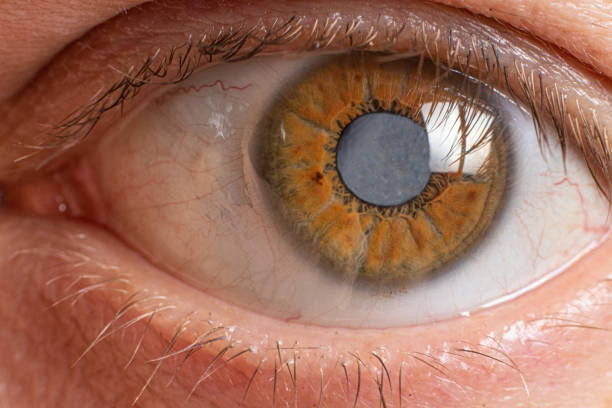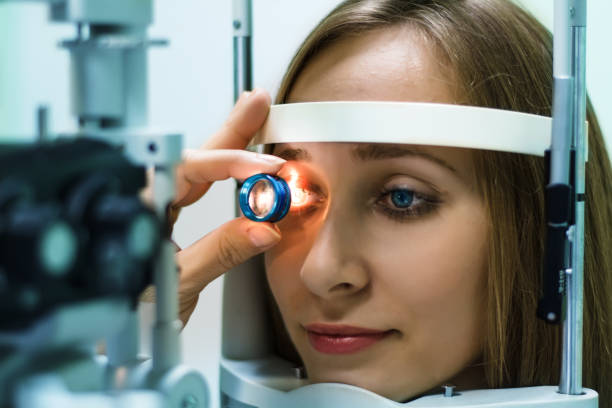Glaucoma is a disease that destroys the optic nerve, which is the nerve responsible for transmitting electrical impulses for vision from the eye to the brain. It usually happens when fluid builds up in the front part of your eye. That extra fluid increases the pressure in your eye, damaging the optic nerve.

istock
Pathophysiology of Glaucoma
The eye consistently makes aqueous humor. As new aqueous flows into the eye, the same amount should drain out. The fluid drains out through an area called the drainage angle. This process keeps pressure in the eye (called intraocular pressure or IOP) stable. But if the drainage angle is not working properly, fluid builds up. Pressure inside the eye rises, damaging the optic nerve.
The optic nerve is made of more than a million tiny nerve fibers. It is like an electric cable made up of many small wires. As these nerve fibers die, you will develop blind spots in your vision. You may not notice these blind spots until most of your optic nerve fibers have died. If all of the fibers die, you will become blind.
It is this raised pressure that compresses and damages the optic nerve. Once the optic nerve is damaged, it fails to carry visual information to the brain and this results in loss of vision.
It is believed that the raised pressure on the retina causes the cells and nerve ganglions in the sensitive retina to die off (retinal ganglion apoptosis) and in addition the small blood vessels of the retina are also compressed depriving it of nutrients. This results in a clinically progressive loss of peripheral visual field and ultimately vision.
Types of Glaucoma
The condition glaucoma consists of two major types
1. Primary open-angle glaucoma:
This is the most common type of glaucoma. It happens gradually, where the eye does not drain fluid as well as it should -kind of like a blocked pipe. As a result, eye pressure builds and starts to damage the optic nerve. This type of glaucoma is painless and causes no vision changes at first.
Some people can have optic nerves that are sensitive to normal eye pressure. This means their risk of getting glaucoma is higher than normal. Regular eye examinations are important to find early signs of damage to their optic nerve.
2. Angle-closure glaucoma: also known as closed-angle glaucoma or narrow-angle glaucoma
This type happens when a person's iris is very close to the drainage angle in their eye. The iris can end up blocking the drainage angle. You can think of it like a piece of paper sliding over a sink drain. When the drainage angle gets completely blocked, eye pressure rises very quickly. This is called an acute attack. It is a true eye emergency, and an ophthalmologist should be consulted immediately or else, it could lead to blindness.
Causes Of Glaucoma
Less-common causes of glaucoma include a blunt or chemical injury to your eye, severe eye infection, blocked blood vessels inside your eye, and inflammatory conditions. It’s rare, but eye surgery to correct another condition can sometimes bring it on. It usually affects both eyes, but it may be worse in one than the other.
Symptoms Of Glaucoma
Most people with open-angle glaucoma don’t have symptoms. If symptoms do develop, it’s usually late in the disease. That’s why glaucoma is often called the "sneak thief of vision." The main sign is usually a loss of side, or peripheral, vision.Symptoms of angle-closure glaucoma usually come on faster and are more obvious. Damage can happen quickly. If you have any of these symptoms, get medical care right away:
- Seeing halos around lights
- Vision loss
- Redness in your eye
- Cloudy-looking eyes (especially in infants)
- Eye pain
Medical Management Of Glaucoma
Your doctor may use;
- prescription eye drops.
- oral medications.
- laser surgery or
- microsurgery to lower pressure in your eye.Eye drops.
These either lower the creation of fluid in your eye or increase its flow out, lowering eye pressure. Side effects can include allergies, redness, stinging, blurred vision, and irritated eyes.
Laser surgery: This procedure can slightly raise the flow of fluid from your eye if you have open-angle glaucoma.

istock
It can stop fluid blockage if you have angle-closure glaucoma. Procedures include:
Trabeculoplasty. This opens the drainage area.
Iridotomy. This makes a tiny hole in your iris to let fluid flow more freely.
Cyclophotocoagulation. This treats areas of the middle layer of your eye to lower fluid production.
Microsurgery: In a procedure called a trabeculectomy, the doctor creates a new channel to drain the fluid and ease eye pressure. This form of surgery may need to be done more than once. The doctor might implant a tube to help drain fluid. This surgery can lead to temporary or permanent vision loss, as well as bleeding or infection.Open-angle glaucoma is most often treated with combinations of eye drops, laser trabeculoplasty, and microsurgery. Doctors tend to start with medications, but early laser surgery or microsurgery could work better for some people.Acute angle-closure glaucoma is usually treated with a laser procedure.Infant or congenital glaucoma is usually treated with surgery because the cause is a problem with your drainage system.

Congratulations @jerrywize! You have completed the following achievement on the Hive blockchain and have been rewarded with new badge(s) :
Your next target is to reach 30 posts.
You can view your badges on your board and compare yourself to others in the Ranking
If you no longer want to receive notifications, reply to this comment with the word
STOPTo support your work, I also upvoted your post!
Check out the last post from @hivebuzz:
Thanks for your contribution to the STEMsocial community. Feel free to join us on discord to get to know the rest of us!
Please consider supporting our funding proposal, approving our witness (@stem.witness) or delegating to the @stemsocial account (for some ROI).
Please consider using the STEMsocial app
app and including @stemsocial as a beneficiary to get a stronger support.